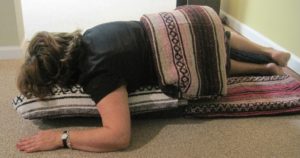Restorative yoga facilitates the four conditions for relaxation: relaxing the muscles with support, quieting the responses caused by stress, quieting the mind, and finding a relaxed, smooth breath. Unlike sleep, where your mind and body are preoccupied with dreaming and tensing muscles, this style of yoga provides an opportunity to achieve all four of these conditions.
The purpose of restorative yoga is two-fold. Restorative active poses awaken dull areas in the body to improve circulation and promote healing, while restorative passive poses induce deep relaxation and recuperation.
Some of the key adjustments to look for include: maintaining round, soft lines in the body and avoiding sharp angles, readjusting props strategically to support the body, filling the space between the body and the earth, and using enough props to create an even path for energy. Most of the adjustments involve accommodating and supporting the body with props. The basic props are blocks, chairs, straps, bolsters, and eye wraps.
Breathing during practice should always be easy and gentle—never forced or strained. Restorative classes encourage students to become aware of the sensations and feelings of breathing. They provide a chance to experience breath, without muscular effort, that brings about opening, healing, and a calm state of mind. Sometimes students will access deep feelings locked in the mind/body and may experience catharsis.
Excerpt from www.Beyogi.com
Poses
Reclined Twist
Props: bolster, 2-4 blocks, 4 blankets, neck roll, eye pillow
Extras: blanket for warmth
Benefits: Allows breath to come in to the rib cage and belly more freely. Detoxifying. Can reduce high blood pressure. Relieves fatigue and insomnia. Safe for a Prenatal twist.
This can be a very prop intensive pose but once you are in it, it is worth it. Begin with right side of body, place the bottom of your right foot against the wall with leg extended. Left leg is bent at a 90 deg. angle and propped up with two blocks and a bolster with maybe a blanket on top. at least two blankets, S-fold blankets, and/or pillows placed along spine for support, lengthwise. Extend your left arm out to the left side and lay it on a smaller stack of blankets either s-fold or triple-fold out to your side. Right arm extends out to the right. This means the left arm is at a higher elevation than right. Head can remain neutral to ceiling or turn to one side. Extra blankets can be placed in spaces that need more support. Neck roll for cervical spine and eye pillow.
*we are digging placing the arms in Goddess pose (not pictured) so try that one out as well. Place blanket support under arms.
Revolved Twist
Props: bolster, 3 blankets, 1 extra blanket for warmth and or laying on lower back to ground
Benefits: Gentle twist for the spine (quadratus lumborom) Releases stress on the back muscles and a stretch to the intercostal muscles. As muscles relax, breathing is enhanced.
Set one bolster lengthwise on your mat. Depending upon your comfort, height can be elevated with blocks under bolster. Lay one blanket on top double-fold and one double-fold at end of bolster where your right hip will go. Sit next to bolster with your right hip touching it, bend knees, left or top ankle can lay in arch of right foot or other comfortable position for feet. For added comfort, place blanket between legs. Lengthen body over bolster, laying bent legs in one directions and upper body facing down on bolster. Arms drape down sides of the bolster.


Leave A Comment